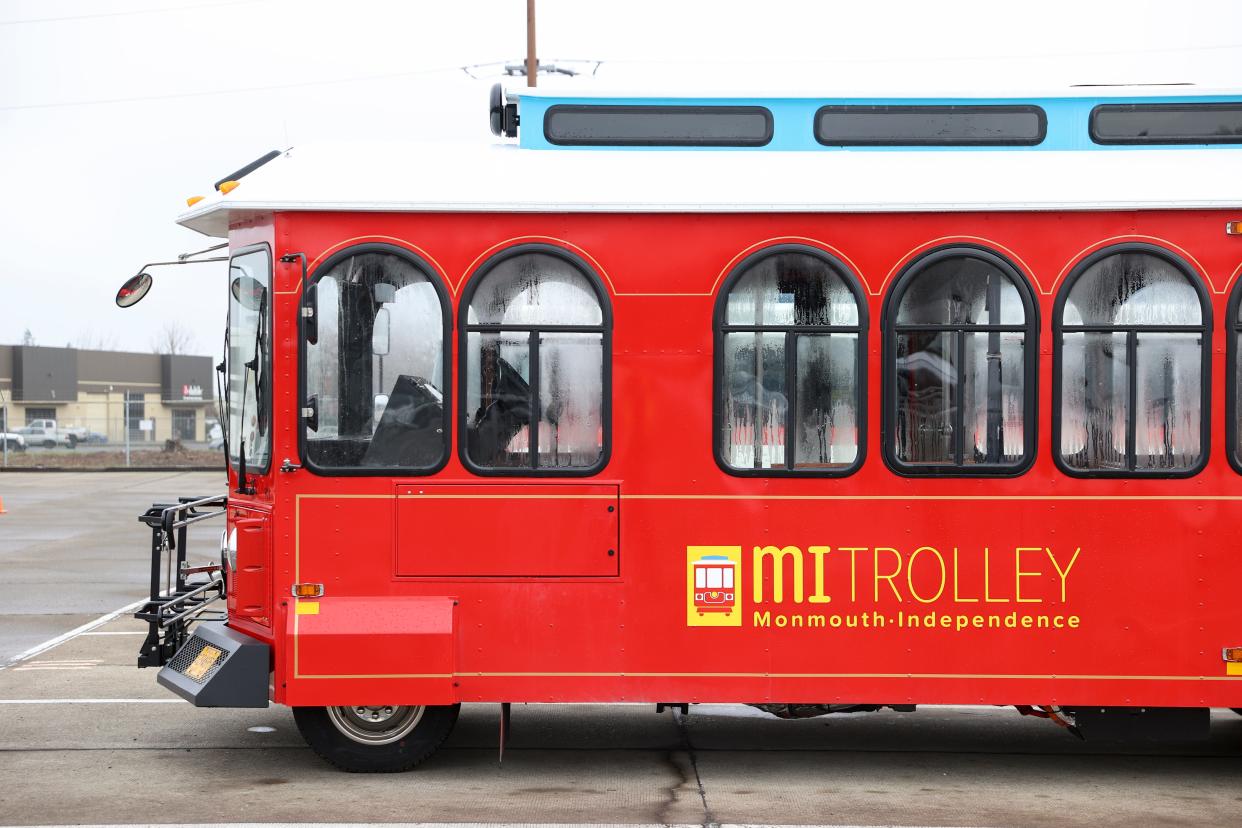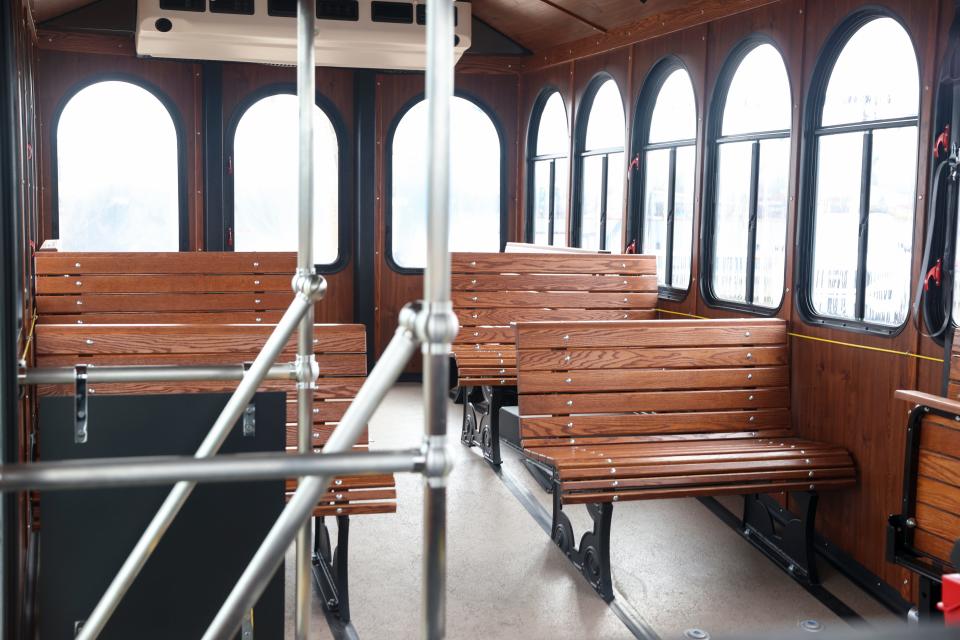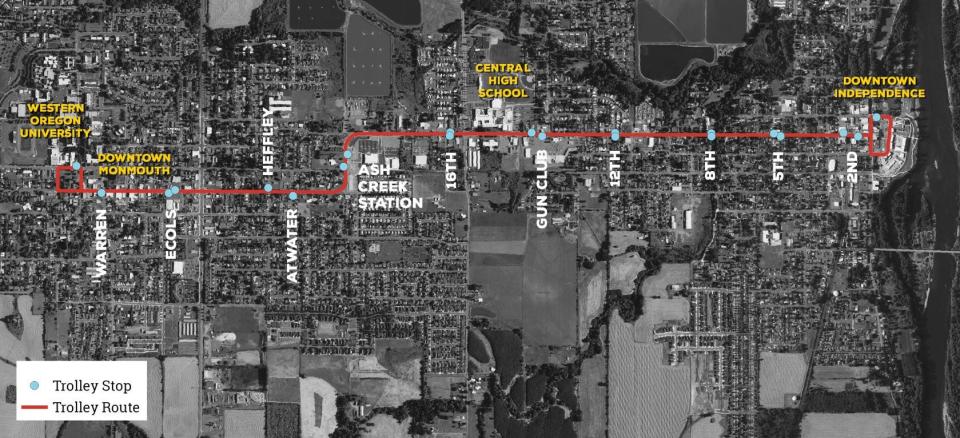It's taken a century to bring 'trolleys' back to Monmouth and Independence

When Paul Evans was an 18-year-old, first-time city councilor in Monmouth in 1988, he went to coffee shops and barber shops around town to hear what some of the city’s older residents would talk about.
A frequent topic was a trolley that ran between the city and neighboring Independence until 1918. Evans said residents talked about how they would love to have a trolley again.
The trolley had been gone for about 70 years at that point, and Evans said he wasn't sure if the residents were remembering it or if they were reciting their parent's memories.
After the decades of dreaming and years of planning, the MI Trolley − in the form of buses decorated and designed to look like trolley cars − is scheduled to begin a two-year pilot of free service between the Polk County cities on Sunday. The buses will be operated by Cherriots public transit.
A ribbon cutting is scheduled for 3 p.m. Sunday at the Polk County Fire District station at 1800 Monmouth St. in Independence.
The buses are being paid with $3 million in American Rescue Plan Act funds. Rep. Evans, D-Monmouth, said that he put the $2 million he was allowed to allocate as a state lawmaker to the trolley project, and State Sen. Deb Patterson – who’s district also includes the cities – put $1 million toward it.

Independence and Monmouth railroad history
From 1889 to 1918, the Independence & Monmouth railroad operated on a 2.5-mile stretch of track between the two cities.
The line had depots in both downtowns and one stop in-between. It had three locomotives, according to stories from the day.
The privately owned line was advertised as the shortest rail line in the world. At one point, the service expanded to connect with cities including Dallas, Arlie, Falls City and West Salem.
But the railroad was rarely profitable – at one time it charged passengers extra to bring bags – and it was sold for a reported $20,000 and most of the tracks pulled up.
The new version of the trolley will connect two cities that look much different than in 1918.
When the trolleys were discontinued, the two communities had a combined population of about 2,000; now they have about 21,000. And most people have cars and the roads are paved.
Bringing the 'trolley' back
The desire for trolley service never stopped. But money was always an issue.
By 2018, Evans was the state representative for the area. He helped secure $300,000 to create a feasibility study for the trolley.
Independence city planner Fred Evander said the study cost about $55,000. “Those funds are still at the city of Independence and we’re still planning on using them for trolley operations,” Evander said.
Then it was a matter of searching for more money, a lot more money, to launch. When ARPA funds were directed to Oregon, Evans saw an opportunity.
“Because it’s economic development, my belief was if you put the money there and generate economic development in the communities,” Evans said.
Monmouth city manager Marty Wine said each of the buses cost $220,000, leaving about $2.3 million for operations. The line is expected to cost $115 per hour to operate.
“Why do we need it?” Wine said. “I don’t know if we need it. I think the purpose of the pilot is to find out if we need it.”
What is the need for mass transit in small towns?
Public transportation exists in Monmouth and Independence.
Cherriots operates two routes, one that goes up Monmouth and Main Street and continues on to Dallas. The other includes that route and goes into Salem.
But those are infrequent with 10 one-way trips per day.
Western Oregon University also operates WOLF Ride, a free van riding service for students, which operates from 5-11 p.m.
“We identified at that point, hey, if we do this well, the likelihood that we could do the service better than the other two services was very high,” Evander said.
The current options aren't going away, however.

140 trips per day between Independence and Monmouth
One of the main things the study identified was it had the best chance of attracting riders if it makes frequent trips. The initial schedule will have 140 one-way trips per day.
The MI Trolley − pronounced "my" − is scheduled to run every 20 minutes from 7 a.m. to 9 p.m. Mondays through Saturdays. On Sundays and holidays, they'll run from 8 a.m. to 6 p.m.
To accomplish such frequency, the trolley's will go straight up Monmouth Street in Independence as it becomes Main Street in Monmouth. It will connect Western Oregon University and downtown Independence with that route.
A resident can request one deviation from the route. That way, the trolley will pick them up at their house or business. But they have to book it 24 hours in advance.
“If you are going to use federal transit money for transit service, you need to also basically have on-demand service to make it accessible for everybody,” Wine said.
The route travels past Central High School in Independence, making it convenient for students, including those who participate in after-school activities.
Economic development opportunities
The organizers see multiple ways that economic development could be spurred.
Evans said Western Oregon University's 3,000-plus students and many other residents often leave town for things like concerts and restaurants.
He said he'd like to see people to stay there and spend their money in the community. He envisions people in Monmouth taking the busses to Independence for things like going to dinner, the movie theater and a drink at a bar before going home. Or people who live in Independence going to Monmouth for a concert at the park and dinner.
“It basically creates an opportunity for once you get on, you cannot have to worry about driving,” Evans said.
Evander said there are a few areas along the route that are undeveloped commercial pads, including around Central Plaza in Independence and the Roth’s Fresh Markets in Monmouth.
“When you consider things like the street car in the Pearl District up in Portland, they put in that street car and it encouraged a bunch of investment along the line. It’s not just the ridership goals that I think that we should be striving for,” Evander said.
It will need money to keep going beyond the trial
The program has no funds to continue beyond the first two years.
But there are possibilities, including money from state agencies because the buses can get people to medical appointments and be used in times of natural disaster, Evans said.
But for that to have a chance, they need to show that public transportation in small towns can attract riders.
“It unlocks some things that I think it’s time to unlock,” Evans said.
Bill Poehler covers Marion County for the Statesman Journal. Contact him at bpoehler@StatesmanJournal.com
This article originally appeared on Salem Statesman Journal: Free 'trolley' to connect Monmouth and Independence, Oregon

